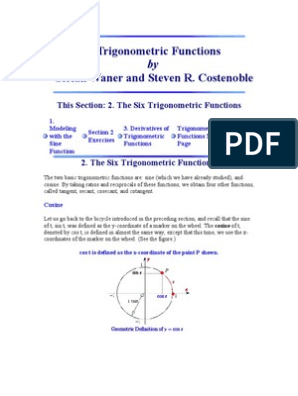0% found this document useful (0 votes)
80 views6 pagesTrigonometric Curves: by Amit Pawar
The document discusses trigonometric curves defined by sine and cosine functions. It explains that sine curves with an amplitude value of 3 will oscillate between +3 and -3 on the y-axis, completing one cycle every 2π units on the x-axis. It also describes how changing the angle in a sine function, such as sin(t-π/3), results in a phase shift of the curve along the x-axis. Finally, it provides a general formula for modifying trigonometric functions through amplitude, period, phase shift, and vertical shifting.
Uploaded by
Amit PawarCopyright
© Attribution Non-Commercial (BY-NC)
We take content rights seriously. If you suspect this is your content, claim it here.
Available Formats
Download as PPTX, PDF, TXT or read online on Scribd
0% found this document useful (0 votes)
80 views6 pagesTrigonometric Curves: by Amit Pawar
The document discusses trigonometric curves defined by sine and cosine functions. It explains that sine curves with an amplitude value of 3 will oscillate between +3 and -3 on the y-axis, completing one cycle every 2π units on the x-axis. It also describes how changing the angle in a sine function, such as sin(t-π/3), results in a phase shift of the curve along the x-axis. Finally, it provides a general formula for modifying trigonometric functions through amplitude, period, phase shift, and vertical shifting.
Uploaded by
Amit PawarCopyright
© Attribution Non-Commercial (BY-NC)
We take content rights seriously. If you suspect this is your content, claim it here.
Available Formats
Download as PPTX, PDF, TXT or read online on Scribd
/ 6





























































